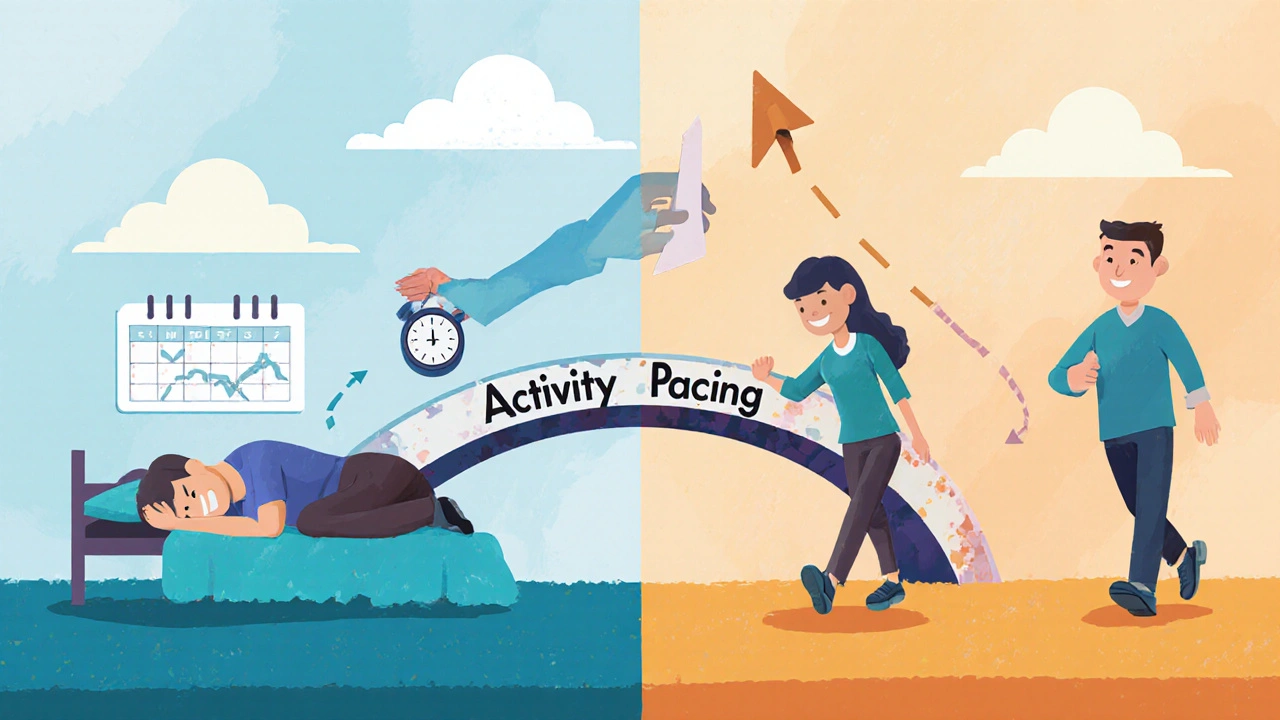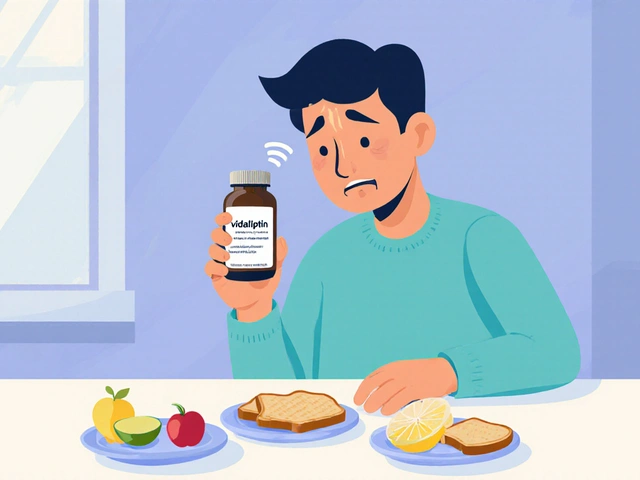 10
Nov,2025
10
Nov,2025
What CBT for Chronic Pain Actually Does
Chronic pain isn’t just a physical problem. If you’ve lived with it for months or years, you know it doesn’t just hurt-it drains you. It makes you anxious, isolates you, and turns simple tasks into battles. That’s where CBT for chronic pain comes in. It doesn’t erase the pain, but it changes how you respond to it. Developed in the 1970s by pain psychologists like Dennis Turk and Robert Kerns, Cognitive Behavioral Therapy for Chronic Pain (CBT-CP) is built on one simple idea: your thoughts, emotions, and behaviors shape how much pain affects your life.
Unlike medications that target nerves or inflammation, CBT-CP works on the brain’s interpretation of pain. It doesn’t pretend the pain isn’t real. Instead, it helps you stop letting fear, frustration, and negative thinking make it worse. Think of it like retraining your nervous system to stop sounding the alarm when there’s no real danger.
How CBT for Chronic Pain Works
A typical CBT-CP program lasts 8 to 16 weeks, with weekly 60- to 90-minute sessions. These aren’t just talking sessions-they’re skill-building workshops. You learn tools you can use every day, whether you’re at home, at work, or in the middle of a flare-up.
- Pain neuroscience education: You learn how pain signals work in the body and brain. This helps you understand that pain doesn’t always mean damage. Many people are shocked to find out that pain can persist even after tissue heals.
- Cognitive restructuring: You identify thoughts like “I’ll never get better” or “This pain controls my life” and replace them with more balanced ones: “I’m having a tough day, but I’ve handled this before.”
- Activity pacing: Instead of pushing through pain until you crash (boom-bust cycle), you learn to spread activities evenly. Walk 10 minutes twice a day instead of 20 minutes once and then be stuck in bed for two days.
- Relaxation techniques: Deep breathing, progressive muscle relaxation, and mindfulness help calm your nervous system. When your body is tense, pain feels louder.
- Behavioral activation: You slowly rebuild activities you’ve avoided-like gardening, playing with kids, or going out with friends-not because the pain is gone, but because you’re learning to live with it differently.
What the Research Says
CBT-CP is the most studied psychological treatment for chronic pain. A 2023 review of 13 clinical trials involving over 1,600 people found it consistently improves mood, sleep, and daily function. But here’s the catch: it doesn’t always reduce pain intensity.
Only about 25% of studies showed significant pain reduction compared to standard care. That sounds disappointing-until you look at the bigger picture. The same studies showed:
- 6 out of 8 studies found major improvements in depression
- 5 out of 6 showed clear drops in anxiety
- Patients were 2.3 times more likely to stick with treatment if they completed at least 80% of sessions
And here’s what matters most to people living with chronic pain: in the STAMP trial (2024), 36% of those who did CBT reduced their daily opioid use. Only 17% of those in standard care did. That’s not just a number-it’s a life change.
CBT vs. Other Treatments
Is CBT better than physical therapy? Than mindfulness? Than opioids?
It’s not about which is “best.” It’s about what works for your goals.
| Treatment | Reduces Pain Intensity? | Improves Mood? | Reduces Opioid Use? | Long-Term Benefits? |
|---|---|---|---|---|
| CBT for Chronic Pain | Moderate (25% of studies) | Strong (60-80% of patients) | Yes (36% reduction in STAMP trial) | Yes, if skills are practiced |
| Physical Therapy | Strong | Moderate | No | Yes, if combined with movement habits |
| Mindfulness-Based Therapy | Similar to CBT | Strong | Yes | Yes |
| Opioids | Short-term only | Often worsens | N/A | No-risk of dependence |
| CBT + Physical Therapy | Strongest overall | Strongest | Yes | Best long-term outcomes |
Experts agree: CBT-CP works best when combined with other approaches. The top-performing treatment in a 2022 review was CBT paired with physiotherapy. That’s because physical therapy helps your body move better, and CBT helps your mind stop fearing movement.

Who Benefits Most-and Who Might Not
CBT-CP isn’t a magic bullet, and it’s not for everyone. But it shines in specific cases:
- Great fit: People with chronic low back pain, fibromyalgia, or arthritis who also feel anxious, depressed, or hopeless. If you’ve been told “it’s all in your head,” CBT helps you take back control without dismissing your pain.
- Good fit: Those trying to reduce or stop opioids. CBT gives you tools to manage pain without relying on pills.
- Less effective: People with severe neuropathic pain (like diabetic nerve pain) or those who aren’t ready to change their habits. If you think CBT means “your pain isn’t real,” you’ll struggle.
One 2023 study even found no benefit for some men and women with chronic pain-highlighting that individual differences matter. That’s why matching the right therapist and approach is critical.
Real Stories from People Who Tried It
On Reddit’s r/ChronicPain community, 62% of people who tried CBT said it helped. Common comments:
- “I used to avoid everything. Now I walk 15 minutes every morning. It’s not perfect, but I’m not stuck.”
- “I stopped thinking ‘I can’t do anything’ and started saying ‘I can do this, but I need to take breaks.’”
- “I cut my opioid dose in half after 6 weeks of CBT. I didn’t think it was possible.”
But it’s not all smooth sailing. About 29% of people said CBT felt dismissive: “They kept telling me to change my thoughts, but my back still hurt.” That’s a sign the therapist wasn’t connecting the dots between mind and body.
Successful patients all had one thing in common: they worked with someone who understood pain wasn’t just psychological. The VA’s program trains therapists to say, “Your pain is real. Let’s figure out how to live with it better.”
Getting Started with CBT for Chronic Pain
Here’s how to find the right help:
- Ask your doctor for a referral to a psychologist trained in CBT-CP. Not all therapists know this specific approach.
- Check credentials. Look for someone who uses tools like the Pain Catastrophizing Scale (PCS) or Brief Pain Inventory (BPI). These aren’t just talk-they’re measurements.
- Ask about format. In-person works. Video sessions work just as well (a 2021 study showed equal results). If you’re in a rural area, telehealth might be your only option.
- Start with a trial. Many programs offer a free 15-minute consultation. Ask: “Do you have experience with chronic pain patients? How do you handle flare-ups?”
- Track your progress. Use a simple journal: rate your pain (1-10), note your mood, and what you did that day. This helps you see patterns.

Barriers and How to Overcome Them
CBT-CP is recommended in 92% of global pain guidelines. But only 32% of community clinics in the U.S. offer it. Why?
- Insurance coverage: Medicare only pays for 10 sessions. Most programs need 10-12. Commercial insurers vary-some cover 8, others 12. Call your plan and ask: “Do you cover CBT for chronic pain under mental health benefits?”
- Therapist shortage: Only 15% of people who could benefit actually get it. Look for university clinics or VA hospitals-they often have lower fees or sliding scales.
- Skepticism: 32% of patients think CBT means “your pain isn’t real.” A good therapist will explain: “We’re not fixing your spine. We’re fixing how your brain reacts to it.”
Successful programs use three tricks: motivational interviewing to build trust, telehealth to boost attendance, and co-location-having the psychologist sit right next to your pain doctor. That reduces confusion and increases follow-through.
The Future of CBT for Chronic Pain
The NIH is spending $14.2 million between 2024 and 2026 to improve CBT-CP. New developments include:
- Digital CBT apps: FDA-cleared apps now guide users through sessions at home. One study saw a 47% increase in usage since 2023.
- Brief CBT: New 4-6 session versions are showing promise for people who can’t commit to 12 weeks.
- Wearable integration: Future programs may sync with fitness trackers to adjust pacing based on your real-time activity levels.
The goal isn’t to replace therapists-it’s to make help more accessible. By 2030, experts predict CBT-CP use will triple as insurers shift to paying for outcomes, not just pills.
Final Thoughts: It’s Not About Eliminating Pain
CBT for chronic pain doesn’t promise a pain-free life. It promises a life with less suffering. It’s about regaining control-not because the pain disappeared, but because you stopped letting it dictate your days.
If you’re tired of treatments that don’t work, or if you’re ready to reduce opioids, or if you just want to play with your grandkids without dreading the next flare-up-CBT-CP gives you tools. It’s not easy. But it’s one of the few approaches that actually changes how you live with pain, not just how you feel it.






This actually worked for me. Cut my oxycodone in half in 8 weeks.
I appreciate the data-driven breakdown, but I'm still skeptical about how much cognitive restructuring can help when your L4-L5 disc is literally collapsing. Pain isn't just a thought pattern-it's a structural reality. CBT can help you cope, but it doesn't fix the biomechanics. And if your therapist doesn't acknowledge that, they're doing a disservice.
The longitudinal efficacy of CBT-CP is indeed compelling, particularly when contextualized within the broader biopsychosocial model of chronic pain management. It is worth noting, however, that the reduction in opioid utilization observed in the STAMP trial-while statistically significant-is not universally replicable across socioeconomic strata, particularly in regions where access to consistent psychological care remains structurally limited. Furthermore, the integration of CBT with physical rehabilitation protocols appears to yield synergistic benefits that neither modality achieves independently, suggesting that a multidisciplinary approach remains the gold standard. One might also consider the role of neuroplasticity in sustaining these gains over time, as repeated engagement with cognitive restructuring techniques appears to modulate default mode network activity, thereby reducing pain-related rumination.
I tried CBT. The therapist kept saying 'your thoughts are making the pain worse.' So I stopped going. Turns out my spine is fused in three places. Guess my thoughts were just being dramatic about the bone grinding on bone. Thanks for the gaslighting, mental health industrial complex.
I want to address the misconception that CBT implies your pain isn't real-it's one of the most harmful myths in chronic pain care. A good CBT-CP therapist doesn't minimize your suffering; they help you reclaim agency within it. I've seen patients go from bedridden to gardening again, not because the pain vanished, but because they stopped letting fear dictate their movements. The data supports this: improved mood, reduced opioid use, better sleep. Those aren't side effects-they're life-changing outcomes. If your therapist isn't validating your physical reality while teaching you coping tools, find a new one. You deserve both compassion and competence.
i just wanna say… i was so broken before cbt. i thought i was weak for needing help with pain. but learning to pace myself? saying 'i can do this, but slow' instead of pushing until i cried? that changed everything. i still hurt. but now i live. i went from hiding to hugging my nephew again. and yeah, sometimes the therapist said stuff that felt off-but i kept going because i felt heard. not fixed. heard. that’s enough.
I’ve been in chronic pain for 12 years. I’ve tried everything. CBT didn’t make my pain go away, but it made me stop hating myself for not being 'strong enough' to deal with it. The pacing thing? Game changer. I walk 10 minutes twice a day now. I used to do 30 and crash for three days. I’m not cured. But I’m not defeated anymore.
In India, access to CBT-CP is almost nonexistent outside major cities. Most doctors still prescribe opioids or suggest bed rest. I found an online CBT program through a university in Bangalore-free, but only in Hindi. I had to translate everything myself. It took twice as long, but I’m now off tramadol and walking my dog again. If you're reading this and you're in a place with no resources: don't wait for the system to catch up. Use YouTube, apps, Reddit. Find your tribe. You are not alone.
i just got referred to a cbt therapist and i was terrified. what if they think i’m faking it? turns out she asked me about my dog, my job, my sleep-then said 'your pain is real, but your brain’s been screaming 'danger' for too long.' i cried in the parking lot. that’s the first time anyone said that.
Let’s be precise here: CBT-CP does not 'retrain the nervous system'-that’s neuroplastic jargon without mechanistic grounding. The nervous system doesn’t 'learn' pain; it becomes sensitized through peripheral and central mechanisms. CBT modulates top-down cortical regulation of nociceptive processing-primarily via the prefrontal cortex and anterior cingulate-thereby altering affective, not sensory, dimensions of pain. And yes, the STAMP trial’s 36% opioid reduction is statistically significant-but the effect size is modest (Cohen’s d = 0.41), and long-term adherence drops precipitously after 6 months without reinforcement. So: useful? Yes. A panacea? No. A tool-used correctly, with proper monitoring, and in conjunction with physical interventions? Absolutely.
I just read Samantha’s comment. She’s right. My therapist last year said 'just think positive' and I quit. My new one says 'your pain is real, let’s figure out how to live around it.' Huge difference. I’m back in sessions.